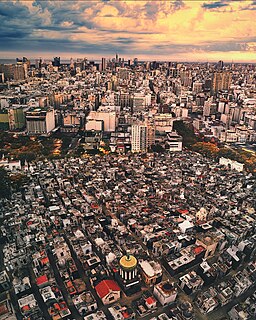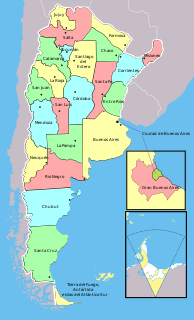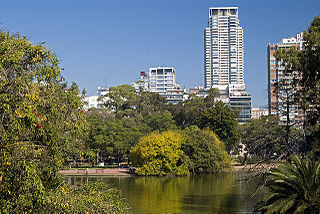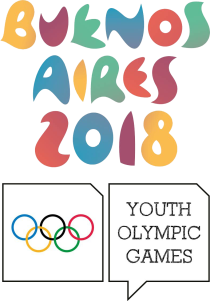
La Recoleta Cemetery is a cemetery located in the Recoleta neighbourhood of Buenos Aires, Argentina. It contains the graves of notable people, including Eva Perón, presidents of Argentina, Nobel Prize winners, the founder of the Argentine Navy, and a granddaughter of Napoleon. In 2011, the BBC hailed it as one of the world's best cemeteries, and in 2013, CNN listed it among the 10 most beautiful cemeteries in the world.

Argentina is subdivided into twenty-three provinces and one autonomous city, Buenos Aires, which is the federal capital of the nation as decided by Congress. The provinces and the capital have their own constitutions, but exist under a federal system.

Buenos Aires, officially Autonomous City of Buenos Aires, is the capital and largest city of Argentina. The city is located on the western shore of the estuary of the Río de la Plata, on the South American continent's southeastern coast. "Buenos Aires" can be translated as "fair winds" or "good airs", but the former was the meaning intended by the founders in the 16th century, by the use of the original name "Real de Nuestra Señora Santa María del Buen Ayre", named after the Madonna of Bonaria in Sardinia. The Greater Buenos Aires conurbation, which also includes several Buenos Aires Province districts, constitutes the fifth-most populous metropolitan area in the Americas, with a population of around 15.6 million.

Buenos Aires is the largest and most populous Argentine province. It takes its name from the city of Buenos Aires, the capital of the country, which used to be part of the province and the province's capital until it was federalized in 1880. Since then, in spite of bearing the same name, the province does not include Buenos Aires proper, though it does include all other parts of the Greater Buenos Aires metropolitan area. The capital of the province is the city of La Plata, founded in 1882.

The Argentine Confederation was the last predecessor state of modern Argentina; its name is still one of the official names of the country according to the Argentine Constitution, Article 35. It was the name of the country from 1831 to 1852, when the provinces were organized as a confederation without a head of state. The governor of Buenos Aires Province managed foreign relations during this time. Under his rule, the Argentine Confederation resisted attacks by Brazil, Bolivia, Uruguay, France and the UK, as well as other Argentine factions during the Argentine Civil Wars.

Greater Buenos Aires, also known as the Buenos Aires Metropolitan Area, refers to the urban agglomeration comprising the autonomous city of Buenos Aires and the adjacent 24 partidos (districts) in the Province of Buenos Aires. Thus, it does not constitute a single administrative unit. The conurbation spreads south, west and north of Buenos Aires city. To the east, the River Plate serves as a natural boundary.

Vicente López is a partido located in the north of Greater Buenos Aires in Buenos Aires Province, Argentina. The capital is Olivos. According to the 2001 national census, the partido has 269,420 residents. Vicente López is located 20 km (12 mi) from the city of Buenos Aires and 80 km (50 mi) from La Plata.

The Autódromo de Buenos Aires Oscar y Juan Gálvez is a 45,000 capacity motor racing circuit in Buenos Aires, Argentina built in 1952 under president Juan Perón, named Autódromo 17 de Octubre after the date of Loyalty Day until Perón's overthrow. It was later renamed after Argentinian racing driver brothers, Juan Gálvez and Oscar Alfredo Gálvez.

Karl Hermann Konrad Burmeister was a German Argentine zoologist, entomologist, herpetologist, and botanist. He was born in Stralsund and died in Buenos Aires. A brief biography, with particular reference to his work on phasmids was published by Bragg in 2007.

The nineteenth edition of the South American Championship in football was held in Buenos Aires, Argentina from January 12 to February 10. This tournament, an extra edition with no trophy handed to the winners, is considered official by CONMEBOL.

Florentino Ameghino was an Argentine naturalist, paleontologist, anthropologist and zoologist, whose fossil discoveries on the Argentine Pampas, especially on Patagonia, rank with those made in the western United States during the late 19th century. Along with his two brothers –Carlos and Juan– Florentino Ameghino was one of the most important founding figures in South American paleontology.

Parque Tres de Febrero, popularly known as Bosques de Palermo, is an urban park of approximately 400 hectares located in the neighborhood of Palermo in Buenos Aires, Argentina. Located between Libertador and Figueroa Alcorta Avenues, it is known for its groves, lakes, and rose gardens.

The Buenos Aires Botanical Garden is a botanical garden located in the Palermo neighborhood of Buenos Aires in Argentina. The garden is triangular in shape, and is bounded by Santa Fe Avenue, Las Heras Avenue and República Árabe Siria Street.

The Buenos Aires Zoo was an 45-acre (18 ha) zoo in the Palermo district of Buenos Aires, Argentina. The zoo contained 89 species of mammals, 49 species of reptiles and 175 species of birds, with a total of over 2,500 animals. The institution's goals are to conserve species, produce research and to educate the public. In June 2016 the city formed a bias about the zoo's cruelty. They had to close the 140-year-old zoo and relocate most of the animals to nature reserves, including Temaikèn. The zoo property will be converted into an ecopark.

Balcarce Partido is a partido of Buenos Aires Province in Argentina.

Beatriz Sarlo is an Argentine literary and cultural critic. She was also founding editor of the cultural journal Punto de Vista. She became an Order of Cultural Merit laureate in 2009.

The 2018 Summer Youth Olympics, officially known as the III Summer Youth Olympic Games, and commonly known as Buenos Aires 2018, were an international sports, cultural, and educational event held in Buenos Aires, Argentina between 6 and 18 October 2018. They were the first Summer Youth Olympic Games held outside of Asia, and the first Youth Games for either summer or winter held outside Eurasia. It was the second Olympic Games held in South America after the 2016 Summer Olympics in Rio de Janeiro, Brazil.

The Argentine Civil Wars were a series of civil wars that took place in Argentina from 1814 to 1880. These conflicts were separate from the Argentine War of Independence (1810–1820), though they first arose during this period.
The Parque Olímpico de la Juventud, former Parque Polideportivo Roca is a large park with sports facilities in southern Buenos Aires, Argentina. Located in Villa Soldati, by the Riachuelo, it was opened in 1979 by Osvaldo Cacciatore, de facto Mayor of Buenos Aires during the National Reorganization Process military dictatorship.




















